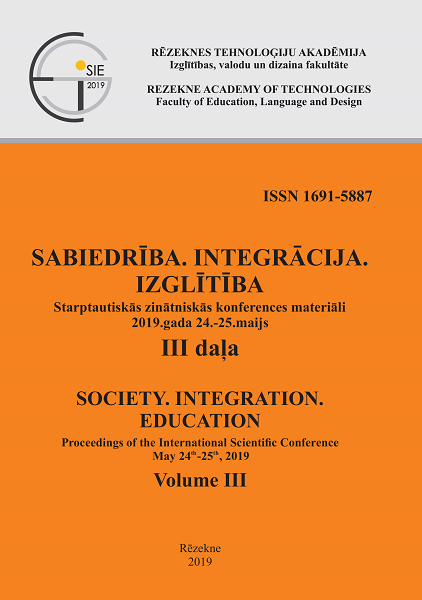WARMING UP THE SCHOOL CLIMATE - PERCEPTION OF THE SCHOOL ENVIRONMENT AND PEER AGGRESSION
DOI:
https://doi.org/10.17770/sie2019vol3.3838Keywords:
cyber aggression, school environment, peer aggression, diagnostic survey, preventive activitiesAbstract
The article sought answers to questions about the significance of subjectively perceived conditions of the school environment for students experiencing cyber aggression. The theoretical framework of the study was comprised by the socio-ecological concept of school environment (Bronfenbrener, 1986) and the concept of resilience explaining the phenomenon of positive adaptation of children and young people (Garmezy 1985). The research was carried out as part of a wider project oriented at introducing changes in schools and using a diagnostic survey. Participation was attended by: schools’ representatives, a local institution dealing with social prevention, and a researcher in the person of the author of the article.References
Agatston, P. W, Kowalski, R., & Limber, S. (2007). Students’ perspectives on cyber bullying. Journal of Adolescent Health. 41(6 suppl), 59–S60.
Anderson, C. (1982). The search for school climate: a review of the research. Review of Educational Research, 52(3), 368–420.
Babbie, E. (2005). Badania społeczne w praktyce. Warszawa: PWN.
Barboza, G. E., Schiamberg, L. B., Oehmke, J., Korzeniewski, S. J., Post, L. A. & Heraux, C.G. (2009). Individual characteristics and the multiple contexts of adolescent bullying: An ecological perspective. Journal of Youth and Adolescence, 38(1), 101-121.
Bauman, Z. (1996). Etyka ponowoczesna, Warszawa: Wydawnictwo Naukowe PWN.
Brand, S., Felner, R., Shim, M., Seitsinger, A. & Dumas, T., (2003). Middle school improvement and reform: development and validation of a school-level assessment of climate, cultural pluralism, and school safety. Journal of Educational Psychology, 95(3), 570–588.
Bronfenbrenner, U. (1986). Ecology of the family as a context for human development: research perspectives. Developmental Psychology, 22(6), 723–742.
Catalano, R., Haggerty, K., Oesterle, A., Fleming, C., & Hawkins, D. (2004). The importance of bonding to school for healthy development: findings from the social development research group. Journal of School Health 74(7), 252–261.
Cohen, J., & Geier, V.K. (2010). School climate research summary: January 2010. Retrieved from http://www.schoolclimate.org/climate/schoolclimatebriefs.php .
Eccels, J. & Roeser, R. (2011). Schools as developmental context during adolescence. Journal of Research on Adolescence, 21(1), 225–241.
Garmezy N. (1985) Stres-Resistant Children: The Search for Protective Factors. In: Stevenson J (Ed.) Recent Research in Developmnetal Psychopatology (213-234). Oxford – New York – Toronto – Sydney – Paris – Frankfurt: Pergamon Press.
Gaziel, H. (1997). Impact of school culture on effectiveness of secondary schools with disadvantaged students. The Journal of Educational Research, 90(5), 310–318.
Gower, A.L., McMorris, B.J., & Eisenberg, M.E. (2015). School-level contextual predictors of bullying and harassment experiences among adolescents. Social Science & Medicine, 147, 47–53.
Han Z., Zhang, G., & Zhang, H. (2017) School Bullying in Urban China: Prevalence and Correlation with School Climate. International Journal of Environmental Research and Public Health, 1, 1–13.
HBSC (2016). Growing up unequal: gender and socioeconomic differences in young people’s health and well-being Health Behaviour in School-aged Children Study: international report from the 2013/2014 survey. World Health Organisation.
Klewin G. (2006). Alltagstheorien über Schülergewalt: Perspektiven von LehrerInnen und SchülerInnen. Wiesbaden: VS.
Komendant-Brodowska, A. (2014). Agresja i przemoc szkolna. Raport o stanie badań. Warszawa: IBE.
Komendant-Brodowska, A., Baczko-Dombi, A., & Giza-Poleszczuk, A., (2011). Przemoc w szkole. Raport z badań. Retrieved from www.szkolabezprzemocy.pl .
Kulesza, M. (2007). Klimat szkoły a zachowania przemocowe uczniów w świetle wybranych badań empirycznych. Seminare, 24, 261-277.
Loukas, A., Suzuki, R., & Horton, K. (2006). Examining school connectedness as a mediator of school climate effects. Journal of Research on Adolescence, 16(3), 491–502.
Masten, A.S., & Powell, J. L. (2003). A resilience framework for research policy and practice. In S. S. Luthar (Ed.), Resilience and Vulnerability (1–28). Cambridge: Cambridge University Press.
McNeely, C., & Falci, C. (2004). School connectedness and the transition into and out of health-risk behavior among adolescents: a comparison of social belonging and teacher support. Journal of School Health 74(7), 284–292.
Mizerek, H. (2018). O wymierającej sztuce dialogu w edukacji, Zarządzanie publiczne, 1(41), 1-10.
Olweus, D. (1997). Bully/victimproblems in school: Facts and intervention. European Journal of Psychology of Education12, 495-510.
Ostaszewski, K. (2012). Pojęcie klimatu szkoły w badaniach zachowań ryzykownych młodzieży. Edukacja, 4(120), 23-38.
Raskauskas, J.L., Gregory, J., Harvey, S.T., Rifshana, F., & Evans, I.M. (2010). Bullying among primary school children in New Zealand: Relationships with prosocial behaviour and classroom climate. Educational Research, 52, 1–13.
Rigby, K. (2010). Przemoc w szkole. jak ją ograniczać. Poradnik dla rodziców i pedagogów. Kraków: Wydawnictwo Uniwersytetu Jagiellońskiego.
Salmivalli, C. (2010). Bullying and the peer group: A review. Aggression and Violent Behavior, 15(2), 112-120.
Salmivalli, C., Lagerspetz, K., Bjorkqvist, K., Osterman, K., & Kaukiainen, A. (1996). Bullying as a group process: Participant roles and their relations to social status within the group. Aggressive Behavior, 22(1), 1-15.
Salmivalli, Ch., Voeten, M., & Poskiparta, E. (2011). Bystanders Matter: Associations Between Reinforcing, Defending, and the Frequency of Bullying Behavior in Classrooms. Journal of Clinical Child & Adolescent Psychology, 40(5), 668–676.
Smith, P.K., Mahdavi, J., Carvalho, M., Fisher, S., Russell, S., & Tippett N. (2008). Cyberbullying: its nature and impact in secondary school pupils. Journal of Child Psychology and Psychiatry, 49, 376-385.
Smith, P.K., Pepler., D., & Rigby, K. (Ed.) (2004). Bullying in schools: How successful can interventions be? Cambridge: Cambridge University Press.
Śliwerski, B., (2003). Nauki o wychowaniu wobec wyzwań postmodernizmu. Chowanna, 1, 9-18.
Tableman, B. (2004). School climate and learning. Best Practice Briefs, 31, 1–10.
Tłuściak-Deliowska, A. (2014). Normy grupy rówieśniczej regulujące zachowanie się w sytuacji dręczenia szkolnego. Psychologia Wychowawcza, 6, 128–138.
Wilson, D. (2004). The interface of school climate and school connectedness and relationship with aggression and victimization. Journal of School Health 74(7), 293–299.






